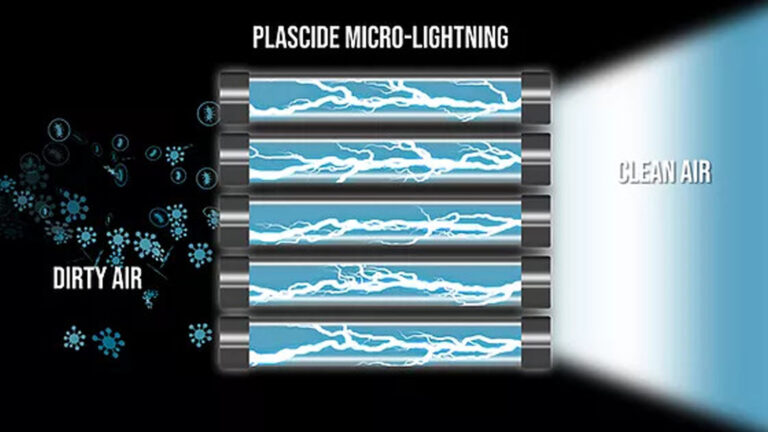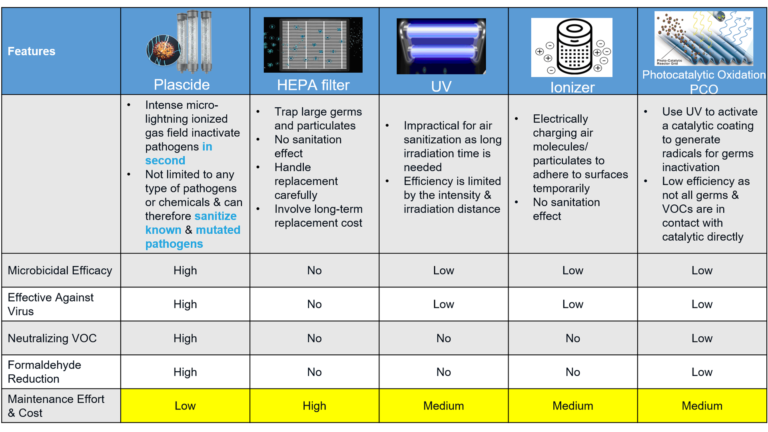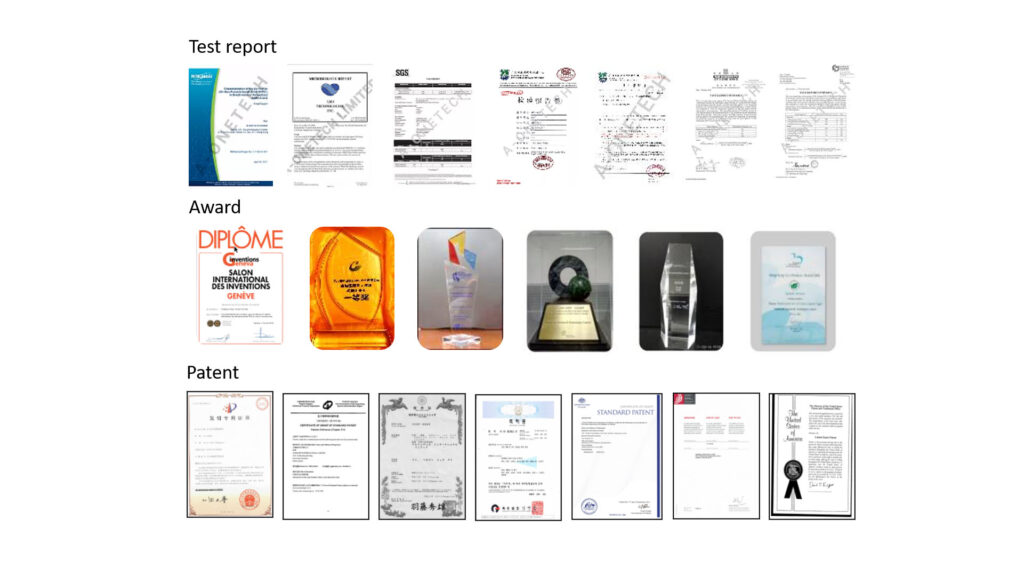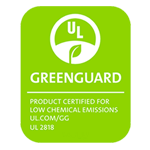What Is the Difference Between an Air Purifier and Air Sanitizer?
People are often confused between an air purifier and an air sanitizer. Both of them will be effective at cleaning the air around them. The main distinction is in their cleaning mode and sanitization depth. For example, air purifiers can remove dust and other larger particles from the air. Meanwhile, air sanitizers like Air Halo use Plascide® Micro-lightning Plasma technology that provides more thorough cleaning. Let us look at some factors for our comparison of air purifiers and air sanitizers.
1. Performance
Firstly the main difference between an air purifier and an air sanitizer is the performance, level of cleaning each can perform. The air purifiers are based on analog porous filters made of fibre material. These filters can catch all the dust and larger particles such as hairs or pollen. However, these devices fail to clear the smaller particles from the air. Moreover, the air purifier’s filters are disposable and last only a few weeks. In some cases, the air purifier uses HEPA filters that can trap larger particulates but not all viruses or tiny aerosols. Trapping has no real sanitization effect and used filters need to be disposed of regularly and carefully, which can be costly in the long run.
On the other hand, air sanitizer like Air Halo can pull the air into the Plascide® reactor, creating a thundercloud of micro-lightning plasma and putting the microscopic particles into an electrified state. Unlike other purification devices that aim to collect harmful pathogens and do not destroy them, Plascide® micro-lightning technology kills viruses, bacteria, and mold without the need for filters. Most filter technologies such as Ozone have a 0% disinfection rate as they can trap harmful microbes in the air with no sanitization effect. Air Halo is not designed to collect. It is designed to destroy. Utilizing the fundamentals of physics, Air Halo electrically sterilizes pathogenic microbes regardless of size or type of pathogen, known or unknown.

2. Effectiveness
In most cases, both air purifiers and sanitizers are similar in their mode of operation. However, the levels of filtration that the air passes are different for both devices. In the case of air purifiers, the air is sucked in through the intake ducts. These ducts are often located at the top of the back of the machine. This air is then transferred to the cleaning filter. This purifier is made of fiber material with a porous surface. Dust and other particles get caught in these small pores while the purified air is transferred to the output chamber.
For instance, UV requires long irradiation, often 10 minutes or longer, making it impractical for air disinfection. Further limits of UV include diminished intensity over distance and the potential to cause other harmful effects. Besides, some Photo-Catalyst Oxidation (PCO) air purifiers use UV to activate a catalytic coating and generate a radical response. While it inactivates some pathogens, not all viruses are within range and its efficacy is easily degraded by dust.

However, the Air Halo is efficacious at deactivating the high airborne challenge of SARS-CoV-2 without the use of filters or particle collection mechanisms and could be beneficial in deterring COVID-19 transmission and effectivity. The Clean Air Delivery Rate (CADR) of the Plascide® is 325 m³/hr which is higher than other technologies. Plus, LMS Technologies, a US laboratory has also verified Air Halo Retrofit HVAC neutralized the MS-2 virus (a surrogate of the SARS-CoV-2) in a single-pass with a residency time of less than 1 second. Moreover, ISO-certified U.S research organization, MRI Global (a world-class virology laboratory) stated Air Halo portable has been proven and validated to kill 99% of SARS-CoV-2 (COVID-19) virus. The University of Hong Kong also has verified this micro-lightning electrocution technology is effective on other airborne pathogens such as H1N1 Influenza, Tuberculosis, and MRSA.

Besides, the Plascide® technology is more effective in instantly delivering sanitized air as soon as it’s switched on, covering your immediate vicinity. It works systematically to perform an in-depth sanitization and leave the air fresh and free of toxins.
3. Maintenance and Flexibility
The maintenance of the air purification devices includes the filter replacement operation. It is a routine procedure that must be followed regularly to keep the machine in good functioning order. The procedure of maintaining an air purifier and an air sanitizer is similar. However, the length of time and cost differ from device to device. Air purifiers are less effective devices that only clean the air of dust and bigger particles. Moreover, some air purifiers are disposable and only last 6–24 months on average before requiring replacement. For example, the HEPA filters can last for up to 8500 working hours before requiring a replacement. On average, the HEPA filter will last anywhere between six months and two years.
But, the average lifespan of the Air Halo portable is ten years. It was designed with ease of use in mind. Plus, it’s filter-free for zero maintenance and zero waste. It contains no consumable elements, low power consumption, and has low maintenance requirements. It also comes in a comprehensive range like Portable, Deskmate, Sanctuary, and Retrofit to meet the various needs from personal and family protection to industrial or commercial use.
Many people get confused when purchasing an air purifier for their homes or offices. They don’t know the difference between these two devices and often end up buying the wrong product. The best air refining devices combine air purifying and air sanitizing technologies to address a wide range of indoor air quality issues. That’s why our Plascide® technology needed to have both a high disinfection efficacy and a revolutionary disinfection speed (within a fraction of a second) because the aerosolized virus-like SARS-CoV-2 as well as other airborne pathogens such as H1N1 Influenza, Tuberculosis, and MRSA that can quickly accumulate and ruin the air quality, infecting others who unknowingly come in contact.
Disclaimer: The above information was gathered from trusted sources and this information are solely from their own research and perspectives.
References
- https://homeairguides.com/hepa-air-purifier-vs-ionizer-or-ionic-air-purifier/
- https://www.lenaire.com/blog/press-releases/uv-air-sanitizers-vs-air-purifiers-a-guide-to-cleaner-air/
- https://aaq.com.my/2021/02/05/difference-between-air-cleaners-and-air-purifiers/
- https://www.gacservices.com/blog/difference-between-air-cleaners-air-purifiers/
- https://www.jacksonandsons.com/differences-air-cleaner-air-purifier/
- https://breathebetterair.org/all-post/air-purifier-vs-air-sanitizer-machine/
- https://www.aaq.com.my/weblog/difference-between-air-cleaners-and-air-purifiers/
- https://oxygarden.com/blog/air-purifier-vs-air-sanitizer-what-to-choose-for-your-home-in-2020/
- https://vitesy.com/blog/air-purifier/difference-air-cleaner-home-air-purifier
- https://www.aaamodernair.com/press-releases/learning-the-difference-between-a-uv-air-sanitizer-and-an-air-purifier/
- https://www.intelligenthanddryers.com/blog/the-differences-between-air-purifiers-and-air-sterilisers
- https://www.gacservices.com/blog/difference-between-air-cleaners-air-purifiers
PRODUCT
FEATURED CASES
WHAT’S NEW
- Redecon Consoles vs Office Furniture
- What Is the Difference Between an Air Purifier and Air Sanitizer?
- The New Norm In The Control Room During Covid-19 Pandemic
- MIRI Global Certified That Air Halo Portable Air Sanitizer Can Eliminate 99% of Covid-19 Virus
- We're Upgrading!
- REDECON Consoles Featured in Pengerang Integrated Complex (PIC)
©2021 Datumstruct CFS | All Rights Reserved

